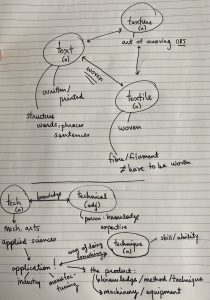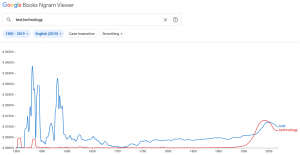Consider the course title, “Text technologies: The changing spaces of reading and writing.” What is text? What is technology? How would you define these terms? Without consulting any resources, record your initial thoughts on these questions.
My definitions:
Text is the combining of letters, phonemes, and words from created by thought and produced by speech or by hand to a recipient. The recipient may be living (ie person or animal) or nonliving (paper, post-it note, computer software). A living recipient will take in the information through sight or sound and make meaning from it with the aid of the brain. A nonliving recipient will function as an inanimate displayer of the information.
Technology is the combination of software and hardware (programs, apps and computing devices) that gathers information from various sources. Through the Internet, technology can broadcast and share texts globally and enable systems to function. Technology is also human-made constructs that enable people to complete tasks. Prehistoric examples include a carving knife and a hunting spear; modern examples include kitchen blenders and smartphones.

Notes on findings:
I was surprised that the definition of text focused solely on written and printed words. As a former International Baccalaureate language teacher, I use to work with globally standardized rubrics that used the word “text” when assessing spoken language. Because of this, I equate this word to both words that we see physically and those that we hear. Upon examining the definitions of “texture” and “textile”, I found that the commonality between these three is the idea of woven. Letters are woven into words; words into sentences… much like fibres and filaments are woven intro fabric. Texture is connected to the art of weaving. After reading the definitions of technology, I was surprised that they were not as specific to constructs that a typical twenty-first century person would list: computers, cell phones, appliances, vehicles etc. The thread that connected the term “technical” to technology was knowledge, and “technique” connected with the idea of “the way of doing something”. I was happy that I included in my definition, the idea that technology is also “machinery or equipment”. When I taught a technology unit for grades 3 and 4, we would explore Indigenous technology as being tools to help create, mold and alter, as well as the subsequent products made from natural resources such as a canoe having been carved from a cedar tree. That is technology!

Notes on Google Ngram using “text” and “technology”:
The word “text” hit two apex points in 1531 and 1581. The word “technology” remained relatively dormant until around 1950 (after having slowly increased starting in the 1930s). Both words were used the same amount of times in 1970. The frequency spiked for technology in 1990 and in 2000 for text.
Further questions:
- What, for example, does textiles have to do with text? As mentioned early, both words and fibres are woven into sentences and fabrics. An author is an artist who weaves his/her thoughts onto the written page in the same manner as an artisan, tailor alters a substance and weaves a fibre into a final product.
- What does teche (teaching) have to do with technology? I believe that the two are interconnected today. My entire day as a 21st Century educator relies on technology. Students in my class use laptops and my lesson plans for each are delivered through and posted on the Canvas platform. True, we will still complete pen and paper activities, both those are nevertheless, examples of technology.
- How has the usage of these terms evolved over the centuries? Consider, for example, how the term technology is used at present by ministries or departments of education. Consider also why many scholars and performers speak of performance (dramatic, filmic, and so on), graphic art, etc., as “text.” As previously mentioned, I would posit that the spoken word is a form of text. I would argue that the human brain forms this words or word images and that they do not need to exist in the physical world for them to be considered text. A personal example of this is that a personal hidden talent that I have is that I can speak backwards. The way I do this is that I can picture the word or entire sentence in my head and I can flip it. I can see the words, I suppose in some odd synesthetic way.
- Can you identify historical events that might have influenced changes in the usage of these terms over time as evidenced in the Google Ngram search? The increase of the word “technology” beginning in the 1950s could be attributed to the increase in manufacturing in the post WW2 boomer era. An example of an important technological invention is the television, which, by the end of the decade, surpassed the popularity of the radio (encyclopedia.com).